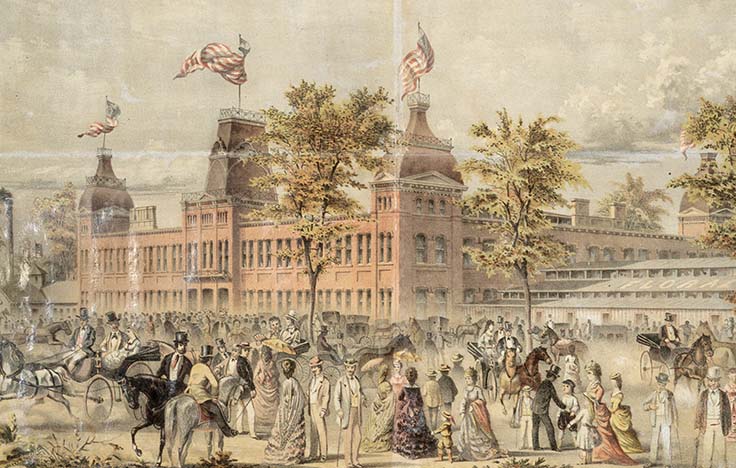
Plan your visit
The Circus That Lived at Camp Morton
December 11, 2019

Featured image: An artist’s rendering of the Exposition Building in 1874.
As part of my job with the Indianapolis Bicentennial Project, I recently processed some materials from the Indianapolis Department of Public Works. Included in that collection are hundreds of original General Ordinances dated from the 1860s to about 1900. Among these, I found (to my transcendent glee) some ordinances related to the circus. Through these, I learned about a piece of circus history in Indianapolis which generally predates the better-known circus past of Peru, Indiana.
General Ordinance No. 5 of 1887 granted a circus called Doris & Colvin the right to show in Indianapolis for one day in April of that year without paying the standard license fee. Thanks to another ordinance in the collection, I knew that as of 1880, this fee was $100 per day for circuses (while other “theatrical performances” visiting the city paid a mere $10). But Doris & Colvin got special treatment because they had been spending their winters in Indianapolis at the State Fairgrounds. Since the show had spent “several thousand dollars” in the area, feeding and sheltering dozens of exotic animals here, the fee was waived by the Common Council.
Around the time of his complimentary Indianapolis date, circus proprietor John B. Doris married his star equestrienne, Ella Stokes. The wedding was held at Denison House, a major hotel at that time, located at the corner of Ohio and Pennsylvania streets.
While a circus wintering in Indianapolis is cool enough, it’s even more remarkable when you consider that the fairgrounds at that time were on the site commonly known as Camp Morton. In 1873, a huge red-bricked exposition building was erected on the site. The front gate of the building was located about where 19th and Alabama streets intersect today. During the fair, the building served to house the many mechanical and technological wonders of the era. But over three winters in the mid-1880s, it housed the elephants, horses, camels, monkeys and other beasts which made up Doris’s menagerie. Many circuses used their winter quarters to generate extra income by offering admission to this temporary zoo. However, I could find no evidence of Doris inviting the public in this manner.
The Indianapolis Department of Public Works Collection will be available to researchers in the coming weeks. As the above demonstrates, the collection offers research opportunities on a wide range of subjects. It shows the day-to-day responsibilities of one of the largest and most important city departments during a time of tremendous growth for the city.









